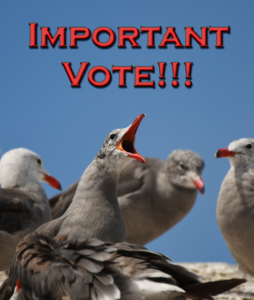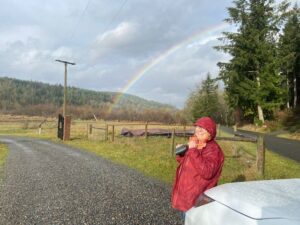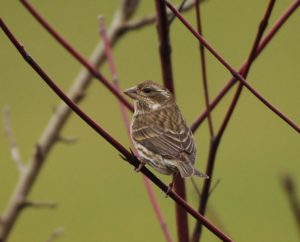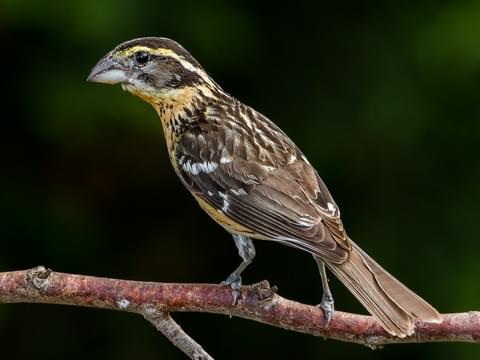
By Sharon Moore
Black-headed Grosbeak –Pheucticus melanocephalus
Family: Cardinalidae
Order: Passeriformes
These showy, vocal, gregarious birds are a joy to welcome back to the Pacific Northwest in late spring. After their arduous spring migration from Mexico in late April they’ve taken up residence with us once again, singing mightily from the treetops with their melodious, whistled warble that is faster and higher pitched than the American Robin’s song. The adult call is a sharp tick and the juveniles’ begging call is a low, plaintive, whistled weeoo. The males are currently courting the females with vigorous singing. A surprising fact is that the females are also singing regularly, if in softer tones than the males. Once the pair begins incubating their eggs they also each sing while on the nest. Cornell ornithologists have observed another unusual vocal behavior that may involve the female singing a full “male” song from the nest. This is possibly to trick the male into thinking she is being harassed and needs him to spend more time incubating and protecting her. In these monogamous avian relationships the males usually acquiesce.
As large songbirds, Black-headed Grosbeaks have a short neck and a short tail that give them a somewhat stocky appearance. The adult males are striking with vibrant, orange bodies, black heads and black and white wings. The underside of their wings when in flight flashes bright yellow. The female’s head is not black but brown. She has a light orange or buff breast and may have streaks on the sides of her breast. When learning to recognize this bird it’s important not to mistake the male Black-headed Grosbeak for the male Spotted Towhee (Ripilo maculatos). At 7 ¾ inches long, the towhee is equal in size to the grosbeak; however, it has red eyes and a black hood running down to the upper chest. The towhee’s sides are rufous colored, the belly is white and the tail is long and black. The towhee also nests lower than the grosbeak in shrubby understory and is primarily a ground feeder.
The unusual molting pattern of these male Black-headed Grosbeaks bares notice. Though the females reach their definitive breeding colors from the molt that precedes their first breeding season, the males gain their adult coloration in a slower, more complicated process. Young males actually go through two molts during their first summer and fall after fledging. Following their first molt they still look like immatures or even appear to be females. Though these males are often capable of breeding, they are less successful at attracting mates than older males, possibly due to females’ preference for older males. The young males must wait a full year or longer before their next molt occurs to create the bright plumage of fully adult breeding males.
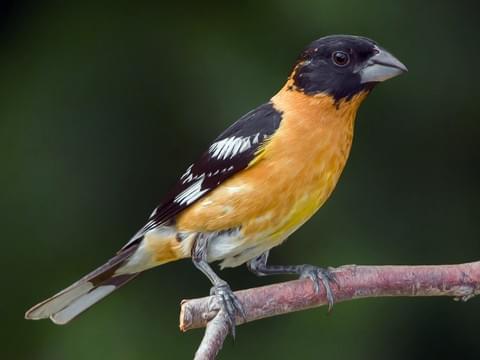
These lovely birds arrive with enthusiasm for the edges of our forests where they can nest safely and access lush, small tree and native shrub understories for the food they need to raise their young. With their thick, triangular bills, they are omnivores which eat across a broad spectrum of insects, seeds, grains, berries, wild and cultivated fruits and even snails and flower buds and blossoms. Generally they forage alone high in flowering, deciduous trees, feeding on buds in the spring. They will also often visit our feeders during the breeding season since they have a special predilection for black-oil sunflower seeds. We currently have two mated pairs and at least one immature male visiting our feeders for those specific seeds.
Black-headed Grosbeak males share much of the burden of raising the young. Initially, though, the female takes on most of the nest-building tasks. First she locates a well-camouflaged spot on an outer branch of a deciduous tree generally up to about 25 feet high. She also locates a good water source nearby. Her construction effort begins by spending considerable time collecting twigs, stems, rootlets and coniferous tree needles for the outer shell of the nest. The exterior of the nest is loosely constructed at about 5 to 7 inches. She then lines the inner surface, a cup 2 to 4 inches deep, with leaves, animal hair, thin stems, even string. This nest is designed to allow the necessary ventilation to keep the eggs and hatchlings cool in late spring.
Once the nest is complete, the female lays two to five eggs and the male actively assists with the 12-14 day incubation period. He also helps with feeding the newly hatched chicks for the next 10 to 14 day period until they climb out of the nest. Unable to fly for up to two weeks, they remain on the branch close to the nest waiting for their parents to feed them. The chicks are in considerable danger from predators from the time they hatch. Though the parents will tolerate species such as warblers and Bushtits that venture near the nest, they ferociously attack predators such as Western Scrub-Jays and Steller’s Jays. These aerial fights are vicious and the grosbeaks are not always successful in protecting themselves and their young from being killed.
With the increasing effects of global warming across the planet, as birders we’re concerned about the future of Black-headed Grosbeaks. In fact, they are currently considered to be a strong, stable population with, as of 2014, fourteen million birds breeding in Canada and much of the U.S. and close to 100% of the total population over-wintering in Mexico. Given these numbers, even with growing urbanization, there is some assurance that the grosbeaks’ strong adaptability will protect them from severe population decline at least in the relatively near future. However, the advance of global warming, if unmitigated, will definitely affect them by causing scarcity of habitat and food sources. For now, the major danger to their wellbeing as a species is far too common nest predation.





